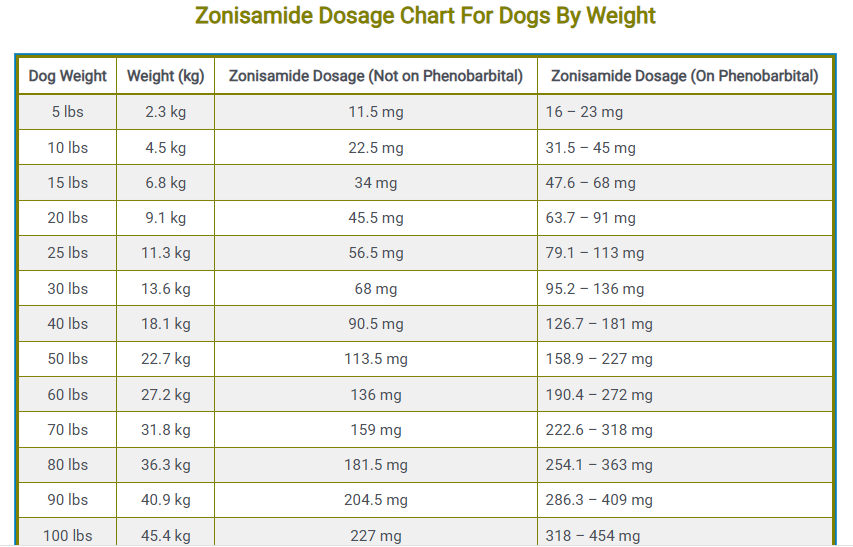Zonisamide is an anticonvulsant medication that was initially developed for humans but has found a valuable place in veterinary medicine—especially for treating seizures in dogs. It’s a sulfonamide-based drug, which means it belongs to the same class as certain antibiotics, though its primary function here is neurological. What makes Zonisamide stand out is its broad-spectrum ability to manage various types of seizures.
While not FDA-approved specifically for dogs, it is commonly prescribed off-label by veterinarians. It’s available in capsule form and typically administered orally. The drug works by stabilizing the electrical activity in your dog’s brain, which helps prevent the sudden and chaotic neuron firing that causes seizures. Because it has a relatively long half-life, it only needs to be given once or twice a day, making it more convenient for pet owners.
Zonisamide’s use in dogs is on the rise, thanks to its effectiveness and relatively mild side effect profile. But it’s not just about controlling seizures—it also helps improve the quality of life for canines suffering from chronic neurological issues. Whether your pup has idiopathic epilepsy or seizures resulting from a brain injury, Zonisamide might be a game-changer.
Zonisamide Dosage For Dogs
The typical Zonisamide dosage for dogs not taking phenobarbital is 5 mg/kg of body weight every 12 hours. However, for dogs who are also on phenobarbital, the dosage often needs to be increased due to drug interactions. In such cases, the recommended Zonisamide dosage for dogs ranges from 7 mg to 10 mg per kilogram of body weight every 12 hours, as prescribed by a veterinarian.
Always consult your vet before starting or adjusting any medication.
Zonisamide Dosage Chart For Dogs By Weight
| Dog Weight | Weight (kg) | Zonisamide Dosage (Not on Phenobarbital) | Zonisamide Dosage (On Phenobarbital) |
|---|---|---|---|
| 5 lbs | 2.3 kg | 11.5 mg | 16 – 23 mg |
| 10 lbs | 4.5 kg | 22.5 mg | 31.5 – 45 mg |
| 15 lbs | 6.8 kg | 34 mg | 47.6 – 68 mg |
| 20 lbs | 9.1 kg | 45.5 mg | 63.7 – 91 mg |
| 25 lbs | 11.3 kg | 56.5 mg | 79.1 – 113 mg |
| 30 lbs | 13.6 kg | 68 mg | 95.2 – 136 mg |
| 40 lbs | 18.1 kg | 90.5 mg | 126.7 – 181 mg |
| 50 lbs | 22.7 kg | 113.5 mg | 158.9 – 227 mg |
| 60 lbs | 27.2 kg | 136 mg | 190.4 – 272 mg |
| 70 lbs | 31.8 kg | 159 mg | 222.6 – 318 mg |
| 80 lbs | 36.3 kg | 181.5 mg | 254.1 – 363 mg |
| 90 lbs | 40.9 kg | 204.5 mg | 286.3 – 409 mg |
| 100 lbs | 45.4 kg | 227 mg | 318 – 454 mg |
Note: Always round doses to the nearest safe capsule size under veterinary guidance. These values are approximations for educational purposes. Always consult a vet before starting or adjusting a dog’s Zonisamide dosage.
Zonisamide 25 mg, 50 mg, 100 mg Capsule Dosage Chart for Dogs
| Dog Weight | Weight (kg) | Not on Phenobarbital (5 mg/kg) | Capsule(s) Required | On Phenobarbital (7–10 mg/kg) | Capsule(s) Required |
|---|---|---|---|---|---|
| 5 lbs | 2.3 kg | 11.5 mg | 1 × 25 mg capsule | 16–23 mg | 1 × 25 mg capsule |
| 10 lbs | 4.5 kg | 22.5 mg | 1 × 25 mg capsule | 31.5–45 mg | 1 × 50 mg capsule |
| 15 lbs | 6.8 kg | 34 mg | 1 × 50 mg capsule | 47.6–68 mg | 1 × 50 mg capsule |
| 20 lbs | 9.1 kg | 45.5 mg | 1 × 50 mg capsule | 63.7–91 mg | 1 × 50 mg + 1 × 25 mg |
| 25 lbs | 11.3 kg | 56.5 mg | 1 × 50 mg + 1 × 25 mg | 79.1–113 mg | 1 × 100 mg capsule |
| 30 lbs | 13.6 kg | 68 mg | 1 × 50 mg + 1 × 25 mg | 95.2–136 mg | 1 × 100 mg + 1 × 25 mg |
| 40 lbs | 18.1 kg | 90.5 mg | 1 × 100 mg capsule | 126.7–181 mg | 1 × 100 mg + 1 × 50 mg |
| 50 lbs | 22.7 kg | 113.5 mg | 1 × 100 mg + 1 × 25 mg | 158.9–227 mg | 2 × 100 mg + 1 × 25 mg |
| 60 lbs | 27.2 kg | 136 mg | 1 × 100 mg + 1 × 25 mg | 190.4–272 mg | 2 × 100 mg + 1 × 50 mg |
| 70 lbs | 31.8 kg | 159 mg | 1 × 100 mg + 1 × 50 mg | 222.6–318 mg | 3 × 100 mg + 1 × 25 mg |
| 80 lbs | 36.3 kg | 181.5 mg | 1 × 100 mg + 1 × 50 mg + 1 × 25 mg | 254.1–363 mg | 3 × 100 mg + 1 × 50 mg |
| 90 lbs | 40.9 kg | 204.5 mg | 2 × 100 mg + 1 × 25 mg | 286.3–409 mg | 4 × 100 mg + 1 × 25 mg |
| 100 lbs | 45.4 kg | 227 mg | 2 × 100 mg + 1 × 25 mg | 318–454 mg | 4 × 100 mg + 1 × 50 mg |
Always follow veterinary guidance. These Zonisamide dosage for dog is general estimates based on standard mg/kg recommendations. Your dog’s exact needs may vary.
Why is Zonisamide Used in Veterinary Medicine?
In the world of veterinary neurology, Zonisamide is like a hidden gem. It’s used primarily for managing epilepsy and chronic seizure disorders in dogs. Its ability to work both as a standalone therapy or in conjunction with other medications like phenobarbital or potassium bromide makes it incredibly versatile.
Veterinarians opt for dog Zonisamide because of several compelling reasons:
- Low toxicity levels make it safer, even for long-term use
- Minimal drug interactions allow it to be paired with other seizure medications effectively
- Once or twice daily dosing reduces stress for both the canine and the owner
- Excellent tolerability even in dogs with liver conditions, unlike some other anticonvulsants
What’s even better? Zonisamide can be used in dogs that haven’t responded well to first-line seizure medications. It’s often introduced when conventional treatments either fail or cause too many adverse effects.
Vets also appreciate that dog Zonisamide doesn’t require the frequent blood testing that drugs like phenobarbital do. It’s a more manageable, modern solution for a very old problem.

Role of Zonisamide in Treating Canine Seizures
Zonisamide plays a pivotal role in the long-term management of seizures in dogs. Once diagnosed with epilepsy or another seizure-causing condition, your vet may recommend this drug either as the first line of defense or as an adjunct to other treatments.
Here’s how it helps:
- Prevents the buildup of abnormal electrical activity in the brain
- Reduces the frequency and severity of both generalized and focal seizures
- Allows for combination therapy without major risk of drug interactions
- Improves quality of life by reducing the unpredictability of seizures
It’s especially helpful in managing idiopathic epilepsy—a condition where no identifiable cause is found. Because these seizures are recurring and often lifelong, a drug like Zonisamide for canonine can make a massive difference in stabilizing your dog’s health.
How Zonisamide Works in Dogs
So how does Zonisamide do its job? Think of it like a traffic cop for your dog’s brain. When neurons start sending signals too fast or in the wrong direction—boom, a seizure can occur. Zonisamide steps in and restores order. It does this by targeting several areas:
- Blocks sodium channels in the brain to prevent rapid, uncontrolled firing of neurons
- Modulates calcium channels which also play a role in nerve signal transmission
- Stabilizes neuronal membranes so that erratic firing is less likely
- Enhances GABAergic inhibition, calming down overactive brain circuits
The result? A more stable neural environment that’s less likely to spiral into a seizure. And because it hits multiple targets, it’s effective across a broader spectrum of seizure types compared to medications that focus on just one pathway.
Benefits of Zonisamide in Dogs
Let’s talk results. The number one reason pet parents and vets turn to Zonisamide is its proven ability to reduce—and sometimes eliminate—seizures in canine.
Whether your dog has daily seizures or just the occasional episode, this medication can significantly improve their quality of life.
How it helps:
- Reduces seizure frequency and intensity
- Helps prevent cluster seizures from spiraling out of control
- Provides control when used alone or with other anticonvulsants
- Delivers quick improvement—often within the first 2-4 weeks
- Continued reduction in seizure activity
- Improved behavior and alertness
- Better appetite and energy levels compared to those on older drugs
- Fewer emergency vet visits due to uncontrolled seizure
Many pet owners report going from daily seizures to none at all after starting Zonisamide. That’s not a fluke—studies and clinical trials have shown success rates between 60–80% in well-monitored canines.
If your dog has been struggling with frequent or uncontrollable seizures, Zonisamide might be the calm in the storm you’ve been hoping for.
Zonisamide Side Effects
One of Zonisamide’s biggest perks is its gentle nature. While every medication comes with potential side effects, Zonisamide tends to be easier on dogs than some of the older anticonvulsants.
Common Side Effects (Usually Mild)
- Sleepiness or lethargy
- Mild gastrointestinal upset
- Loss of appetite
- Ataxia (wobbly gait)
Rare But Serious Side Effects
- Liver issues
- Kidney stones
- Sulfonamide sensitivity (especially in breeds like Dobermans)
What’s especially great is that most mild side effects fade after the first few weeks as your pup’s body adjusts. Compare that to phenobarbital, which can cause liver toxicity and requires frequent blood tests, and you’ll see why Zonisamide is gaining popularity.
Plus, since Zonisamide doesn’t interact with as many drugs, it’s a safer choice for multi-drug regimens—important if your dog has other health issues or is already on meds.
Drug Interactions to Avoid
While Zonisamide plays nicely with many medications, there are a few exceptions. Some drugs may amplify side effects, reduce efficacy, or interfere with absorption.
Be cautious when combining Zonisamide with:
- Carbonic anhydrase inhibitors (like acetazolamide): May increase the risk of kidney stones.
- Diuretics: Can also promote kidney stone formation or dehydration.
- Corticosteroids: May affect how Zonisamide is metabolized, altering its blood concentration.
- Other sulfonamide drugs: May increase the risk of allergic reactions or hypersensitivity.
Important: Always provide your vet with a complete list of medications and supplements your furry friend is taking—including:
Common Alternatives to Zonisamide
When Zonisamide isn’t the right fit, veterinarians may recommend these seizure medications:
- Phenobarbital: A reliable classic, but requires liver monitoring.
- Potassium Bromide: Great for liver-sensitive dogs, though slower to take effect.
- Levetiracetam (Keppra): Fewer side effects, but requires more frequent dosing.
- Gabapentin: Sometimes used for seizure control, particularly in combination with other drugs.
The key is working closely with your vet to find the medication—or combo—that gives your dog the best chance at a seizure-free life.
You May Also Like To Read:
Final Thoughts
Zonisamide for dogs has emerged as one of the most promising medications for managing seizures in dogs. Its balance of effectiveness, safety, and ease of use makes it a strong contender—especially for dogs who don’t respond well to traditional anticonvulsants. From its broad-spectrum action to its minimal side effects and easy dosing schedule, Zonisamide offers a reliable option for dog owners desperate to give their pets a better quality of life.
But it’s not just about stopping seizures—it’s about restoring joy and stability to your dog’s world. Whether you’re just starting out or exploring alternatives, talk to your vet about whether Zonisamide might be the right fit. With patience, consistent care, and the right dose, this medication could be a turning point in your dog’s health journey.
FAQs
How long does Zonisamide take to work in dogs?
Zonisamide usually begins to show results within 1 to 2 weeks, but it may take up to a month for full effectiveness, especially if dosage adjustments are needed.
Can I give my dog Zonisamide with food?
Yes, and it’s often recommended to reduce the risk of stomach upset. Just be sure to give it consistently at the same time each day
What if my dog vomits after taking Zonisamide?
If vomiting occurs within an hour of dosing, contact your vet. They may recommend re-dosing or adjusting the medication schedule.
Is Zonisamide safe for puppies?
Zonisamide can be used in young dogs, but only under veterinary supervision. Dosing for puppies is more sensitive and may require adjustments as they grow.
Can Zonisamide be stopped suddenly?
No. Stopping Zonisamide abruptly can lead to severe seizures. Always work with your vet to taper the dose gradually if discontinuation is necessary.












![Can Dogs Eat Blood? 7 Side Effects [Expert Opinion]](https://petskor.com/wp-content/uploads/2022/04/Webp.net-resizeimage-12.jpg)
